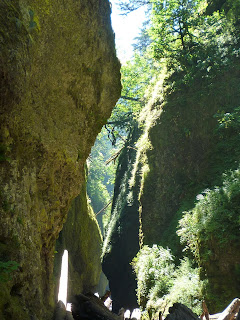There are 26 glaciers that cap the mountain. The mountain is close to the western edge of the North American tetonic plate. The mountain we see today is relatively young in geologic terms: it formed about 500,000 years ago. Like Mount St. Helens and other Cascase volcanoes, Mount Ranier has the potential to erupt again at some unknown time.

We drove inside the park to the visitors center in Paradise. We saw a nice film about the park there and attempted to hike to a waterfall. But as you can see in the pictures below the trails were still snowed in. We attempted to find it but all we found was the information sign buried under about 5 feet of snow.


Later we hiked a trail that took us over this suspension bridge. I don't like walking on these things but this one wasn't too bad.

We drove along the highway inside the park to Reflections Lakes. There are 2-3 lakes together here. The picture below is from the largest one. This is a picture that is taken by everyone who comes here and I am sure you have seen it on TV or a card somewhere. This is an infamous spot to take a picture, so it is very, very popular.

Later we hiked another trail that took us to this small waterfall. Still very pretty though.

On one of the trails this huge tree had fallen and I did my best to upright it, but I just couldn't do it !















































